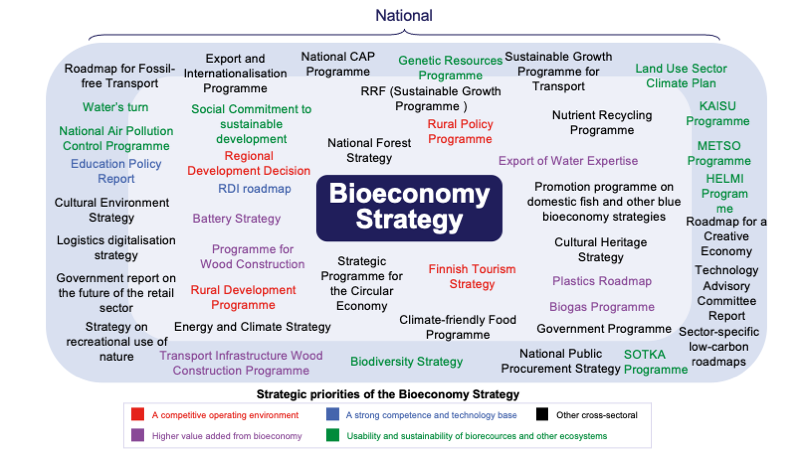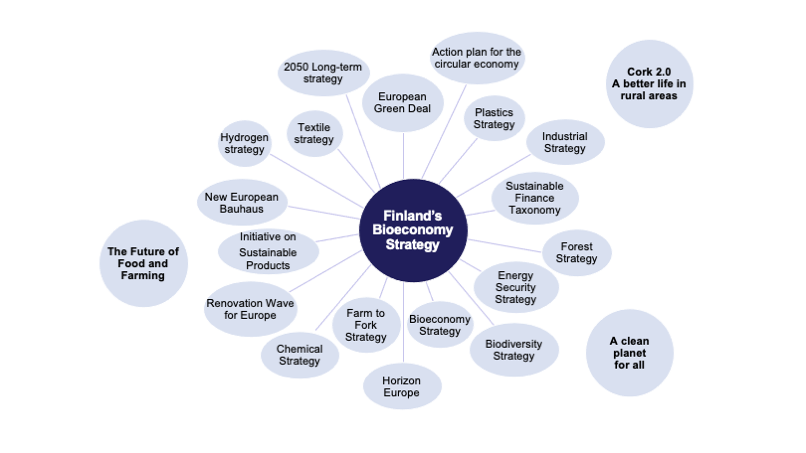1.3 Bioeconomy interfaces with other strategies
The update of the Bioeconomy Strategy examined a wide range of national and EU level strategies and policy programmes that have an interface with the bioeconomy. There is an exceptionally large number of these as shown in the images below. A great deal of attention is focused on the bioeconomy and there are an abundance of wishes related to it, but there are also considerable cross-pressures both in Finland and in the EU.
The ecological, social and economic sustainability of bioresources as well as biodiversity are a necessary and undeniable starting point for the Bioeconomy Strategy. The purpose of the Bioeconomy Strategy is not to challenge or question these basic principles or relevant parallel strategies. For this reason, the objectives and measures outlined in them have not been separately introduced into the Bioeconomy Strategy, but they have been taken into account as interfaces in the preparation of the strategy and as its starting points. Some of them also act as accelerators of demand for new products, services and solutions.
The interactive strategy process has made it clear that the value added and growth potential of different sectors of the bioeconomy have been overshadowed. This increase has not been covered systematically and or in a straightforward manner in the large number of parallel strategies. This is now the key objective of the new strategy. The growth of the bioeconomy’s value added is of considerable importance for the growth of the Finnish economy as a whole.
The Bioeconomy Strategy has interfaces with several other Government strategies and policy programmes that outline, for example, the use of national forest resources, safeguarding biodiversity, climate and energy policy and industrial policy. The Bioeconomy Strategy identifies the strategies and programmes that are central to the bioeconomy, and the policies and objectives set out in them have been taken into account as starting points.
Finland’s targets for carbon neutrality in 2035 and the halting of biodiversity loss will be taken into account in the implementation of the Bioeconomy Strategy. The Government’s sustainability roadmap describes the objectives for ecological, social and economic sustainability, which also guide the promotion of the bioeconomy, in more detail.
National targets for the use of natural resources have been set out in the Circular Economy Action Plan. The aim of the action plan is to reduce the consumption of non-renewable natural resources and increase the productivity of resources and the degree of circular economy in materials. The sustainable use of renewable natural resources plays a key role in achieving these objectives. The National Forest Strategy sets targets in areas such as the management and usability of forest resources, forest biodiversity and climate change mitigation.
The Bioeconomy Strategy’s operating environment is also affected by a number of international commitments, such as the UN 2030 Agenda for Sustainable Development and the implementation of the Paris Agreement. Other national, EU and international strategies, action plans and agreements also have objectives for the sustainable use of natural resources.
The preparation and updating of these national and international strategies and programmes will be taken into account in the monitoring of the Bioeconomy Strategy.
Figure 2: The bioeconomy has interfaces with a large number of other national strategies and programmes.
Figure 3: Finland’s Bioeconomy Strategy under EU review, especially in comparison to the EU Bioeconomy Strategy, but also for a significant number of other strategies, programmes and funding instruments.
See also: Accessible version of figures 2 and 3 with links
1.2 Review of the bioeconomy


